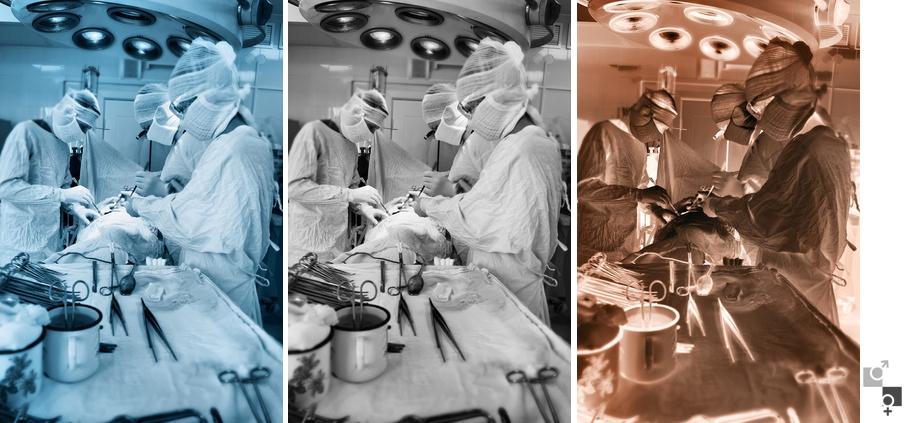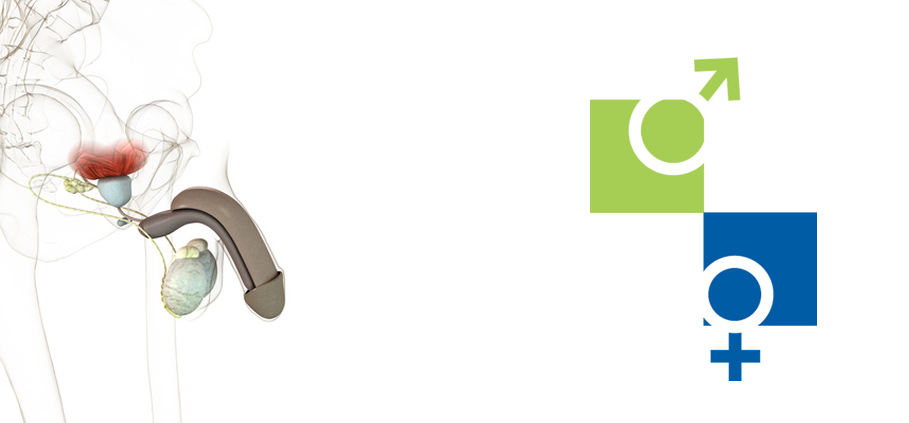Αντιμετώπιση και χειρουργική αποκατάσταση παθήσεων όρχη
-
Testicular Biopsy
The testicular biopsy is a test that enables us to check the existence of malignancy in a newly-found lump in the testis, the dysfunction in the production of sperm or the difficulty in releasing it during ejaculation phase in men with infertility elements. This test is performed with local anaesthesia or sedation using a biopsy needle or by making a small, 1cm incision in the testis. The test is safe and the nuisance that may be experienced by the patient is minimal and treated with common painkillers. Few-hour hospitalization is required and the morbidity of the operation is minimum. video
Unilateral and Bilateral Orchiectomy
Any painless bulge in the testis should be considered a tumor, until the opposite is proved. Lateral orchiectomy is the immediate treatment of testicular cancer. It is performed with high inguinal incision, opening of the inguinal pore, ligature of the spermatic chord and vessels and then removal of the testis. The operation takes approximately one hour and is conducted with spinal or epidural anaesthesia. One-day hospitalization is required, while morbidity is minimal. The surgery does not puts in danger the erectile ability and fertility of the patient. Immediately after surgery, the surgical preparation undergoes histological testing, which shows whether further and additional treatment is required.
In cases of metastatic – hormonal-resistant prostate cancer, where decrease of testosterone levels is an immediate need, a bilateral subcupsular orchiectomy is performed. The operation is carried out with local anaesthesia or light sedation and takes less than one hour. video
Cryptorhidism - Restoration
It is the condition when the testicle is not located in its regular position within the cavity of the scrotum when the child is born. The proper age for the restoration of the condition is when the child is 18-24 months old. Of course there are cases in which the restoration is performed to adult patients also. The operation is carried on with general anaesthesia and its duration depends on the position of the testis (peritoneal cavity, inguinal canal), as there must be preparation of the spermatic vessels and the spermatic chord (where the testis is supported) in order for them to achieve the length required for the testis to reach its normal position. Then the testis is stabilized so it will not return to its prior position. The operation may be laparoscopic or with open surgery, and the option will be decided upon discussion with the Surgeon Urologist and after analyzing the specifics and particularities of each method in conjunction with the patient’s medical history. The operation takes approximately one hour and is carried out with spinal or epidural anaesthesia. One-day hospitalization is required, while morbidity is minimal.
Testicular Torsion – Orcheopexy - Restoration
The restoration of Testicular Torsion – Orcheopexy is an operation that must be performed within 6 hours from the onset of symptoms, due to the increased danger of permanent damage that may occur to the testis. It is usually observed with children and adolescents up to 18 years of age, it can, however, occur to older patients. The operation is carried out with general anaesthesia and its duration is approximately 45 minutes. A small (2cm) incision is made in the scrotum where the testis is firmly positioned so that torsion will not occur again. One-day hospitalization is required, while morbidity is minimal. video
Varicocele - Restoration
It is the dilatation of the veins of the spermatic cord which results in the formation of varicose venous networks. During the operation the urologist surgeon ligates and intersects the dilated testicular venous network in order to stop the retrogression and stagnation of blood around the testis. This is observed at the inner spermatic vain of the left testicular venous system due to anatomic particularities and is restored with a small (3cm) incision in the inguinal area. The operation takes approximately one hour, is carried out with general anaesthesia and the required hospitalization time is usually one day.
There are 4 different surgical techniques:- >Palomo Method, high ligature
- >Ivanissevich Method, inguinal ligature
- >Marmar or Goldstein Method, subiguinal ligature
- >Laparoscopic ligature
Another, non-surgical, method for the treatment of varicocele is the Tauber technique, and consists of the injection of sclerotic substances in the inner spermatic vein with X-ray test.
Which of these techniques will be finally preferred will be decided based on the individual problem and upon discussion with the medical care provider.video
Hydrocele – Surgical Restoration
Hydrocele is the collection of fluid between the petals of the tunica albuginea of the testicle (pre-formed fibrous capsule covering the testes), and is called idiopathically elytroid. The accumulation of fluid is progressive and painless. A small incision is made in the scrotum to open the cavity of the elytroid tunica of the testis. Then the fluid is removed and the elytroid tunica is reversed and firmly fixed in order to efface the already existent cavity so as not to recur. The operation is carried out with general or spinal anaesthesia. One-day hospitalization is required, while morbidity is minimal. Possible nuisance in the scrotum area do not last more than 2-4 hours and are treated with common painkillers. video
Ligature and Excision of the Spermatic Chord – Unilateral or Bilateral
This operation is performed to patients with extended or recurrent infections of the testes and to men who want a permanent contraceptive method. In the latter case, however, a written consent by both the patient and his wife is required. The operation is carried out with local anaesthesia or sedation and by opening a small, 1cm incision in the inguinal area. The operation lasts approximately 30 minutes, is safe and the nuisance that may be experienced by the patient is minimum and can be treated with common painkillers. After the operation the patient must remain in hospital for a few hours for observation. video -
Spermatocele – Surgical Restoration
It is a small, soft cyst which contains accumulated fluid (mostly sperm) on the upper and rear part of the testis. This operation is performed by making a small incision in the scrotum in order to open the cavity of the elytroid tunica, and then identify and remove the cyst. Usually, specimen of the cyst is sent for biopsy. The operation is carried out with general or spinal anaesthesia. One-day hospitalization is required, while morbidity is minimum. Possible nuisance in the scrotal area do not last more than 2-4 hours and is treated with common painkillers. video
Scrotocele/Scrotal Hernia (Bubonocele) – Laparoscopic Restoration
It occurs to men and protrudes through the internal inguinal ring, the point where the testis descends and reaches its final position in the scrotum. This operation can be performed with 3 or 4 open, 3-cm, incisions in the area of the external inguinal ring. During the laparoscopic approach, and aided by special laparoscopic tools, the surgeon reaches the gape inguinal ring, identifies the hernial sack which has prolapsed and after careful preparation, the hernial sack and its content is pushed back inside the inguinal cavity. The gap which remains in the inguinal canal is covered with a special mash.
The operation is carried out with general or spinal anaesthesia. One-day hospitalization is required, while morbidity is minimal. Possible nuisance in the scrotal area does not last more than 2-4 hours and is treated with common painkillers. -
Fournier Disease (Fulminating gangrene of the scrotum) – Surgical Treatment
It is an acute infection and occurs in the external male genitalia. Surgical treatment must be immediate and consists of the surgical excision of the entire pathologic – infected tissue of the scrotum. During the operation, the testes and the spermatic chord remain intact due to the fact that the pathology concerns only the scrotal skin and are covered with vaseline compresses for a long time. The plastic-repairing restoration of the scrotum is performed after a long time period (weeks), as the main cause of the infection must first be treated pharmaceutically. The operation is performed with general anaesthesia. The hospitalization required is unknown and depends of the size of the damage and the post-operative course of the patient, while morbidity is increased.
Testicular Prosthesis – Placement or Removal
The absence of a testis in a man, regardless of his age or the reason of the absence, is a traumatic experience and causes great psychological problems. There are two types of prosthetic implants and they are manufactured in such a way that a support suture can be used in the scrotum in order to limit mobility. The operation is carried out with general anaesthesia, lasts approximately one hour and the incision is made in the inguinal area. The patient must remain in hospital for 24 hours. In cases where the implant causes health problems to the patient, its removal is performed with the same procedure.
Circumcision – Phimosis – Paraphimosis - Restoration
Circumcision is the excision of part of the foreskin which results to revealing the glans penis cannot be revealed due to cicatricial preputial stenosis (stenosis or narrowness of the foreskin) that prevents retraction. At times, several circumcision methods and techniques have been described. In the most common methods, the prepuce is cut circularly, 1cm beyond the end of the cicatricial pathology. After careful haemostasis, the internal petal of the foreskin is stitched to the external petal, using very fine absorbable sutures. The operation does not last more than 35 minutes and is carried out with light general sedation or local anaesthesia, depending on the patient’s age. Full restoration is achieved after 7-10 days, when the patient can return to his normal sexual activity. -



